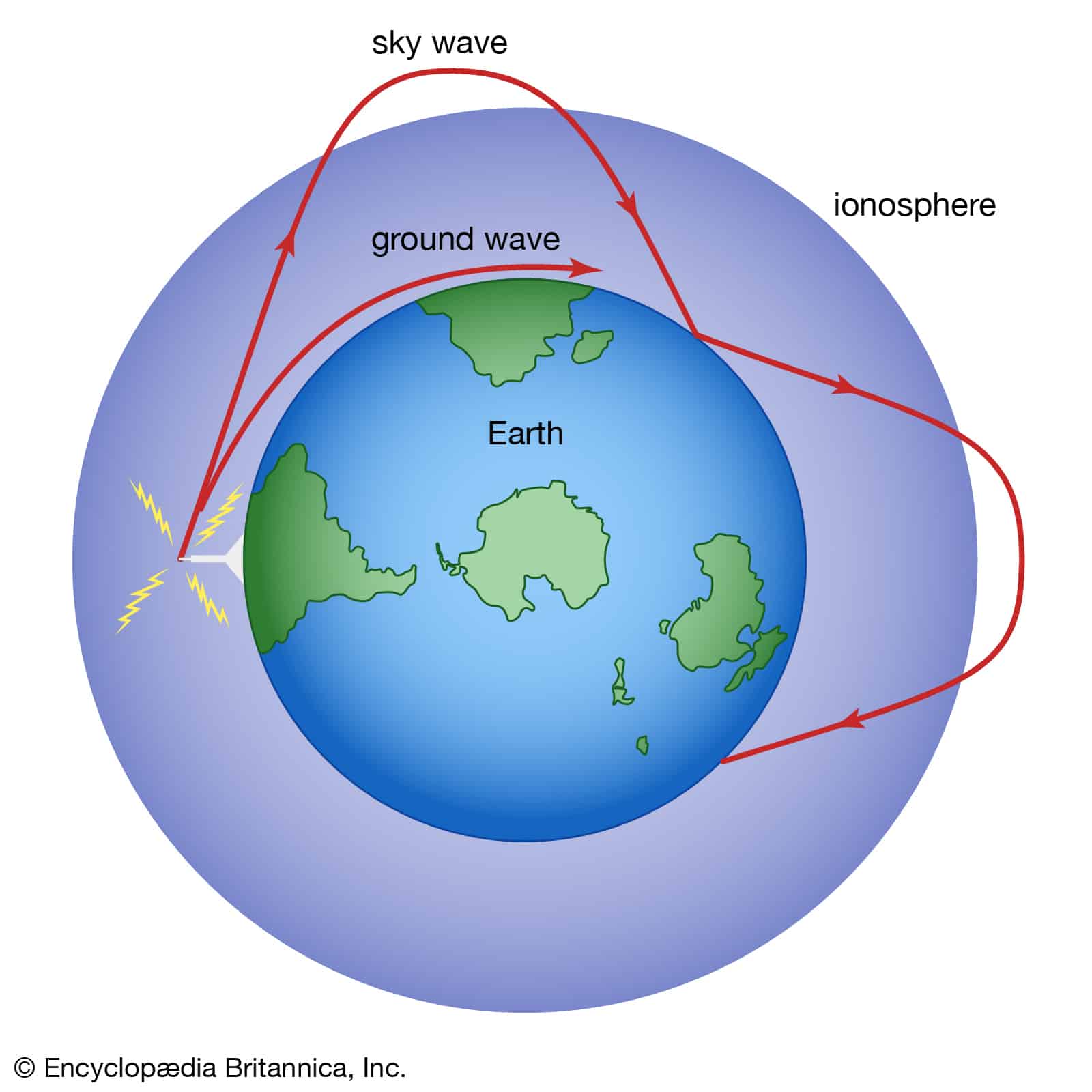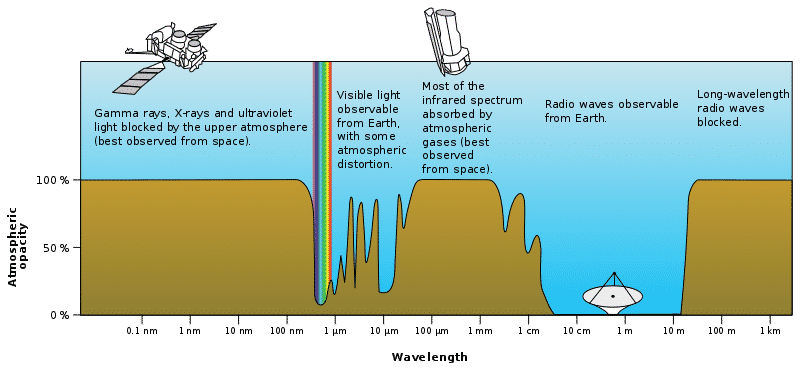What are electromagnetic waves?
If you remember what we learned about waves, you will remember that mechanical waves transmit energy and require a medium (gas, liquid, or solid) for propagation. Electromagnetic waves are different from mechanical waves since they don't need a medium for propagation and hence, can travel through vacuum.
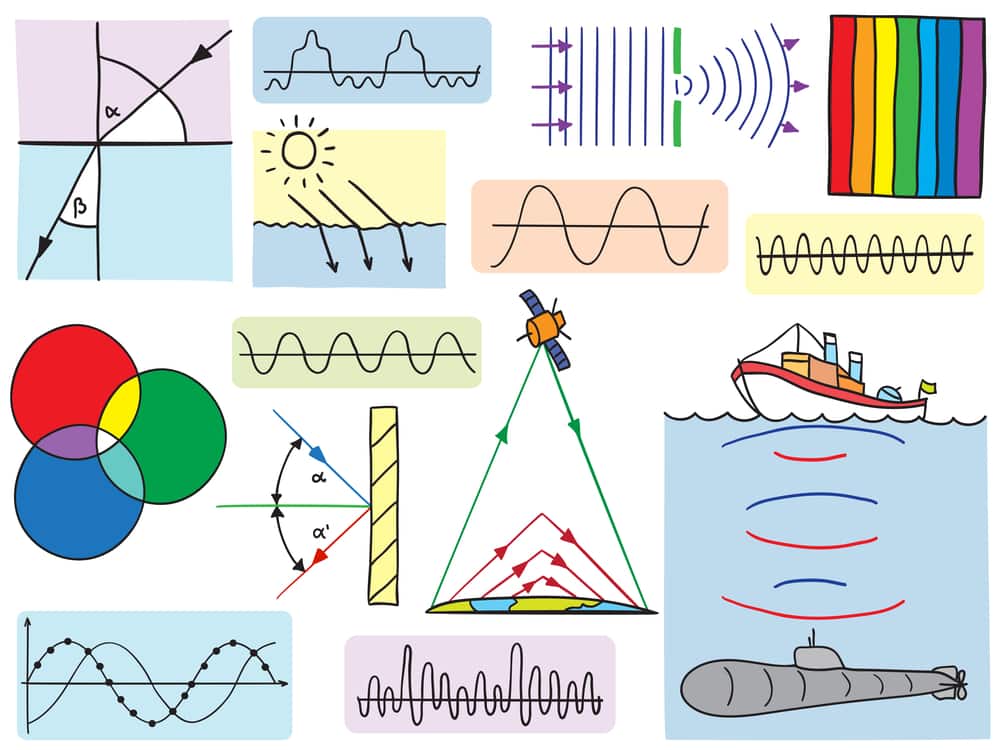
Electromagnetic waves, their properties, behavior and applications
You can read more about the properties and behavior of electromagnetic waves here: How do waves affect your daily life?
To understand how electromagnetic waves are produced, we have to dive into the basics of electromagnetics a little bit.
Electric field
We know that a particle can have any of the three electric charges - positive (For example, proton = unit positive charge), negative (Eg. electron = unit negative charge), or neutral (Ex. neutron). Depending on its electric charge, it might exert an electric force on another object,i.e., opposite charges attract, and the same charges repel each other.
The force with which a unit charge attracts or repels other charges is called the electric field. The electric field flows from a positive charge (outward) to a negative charge (inward).
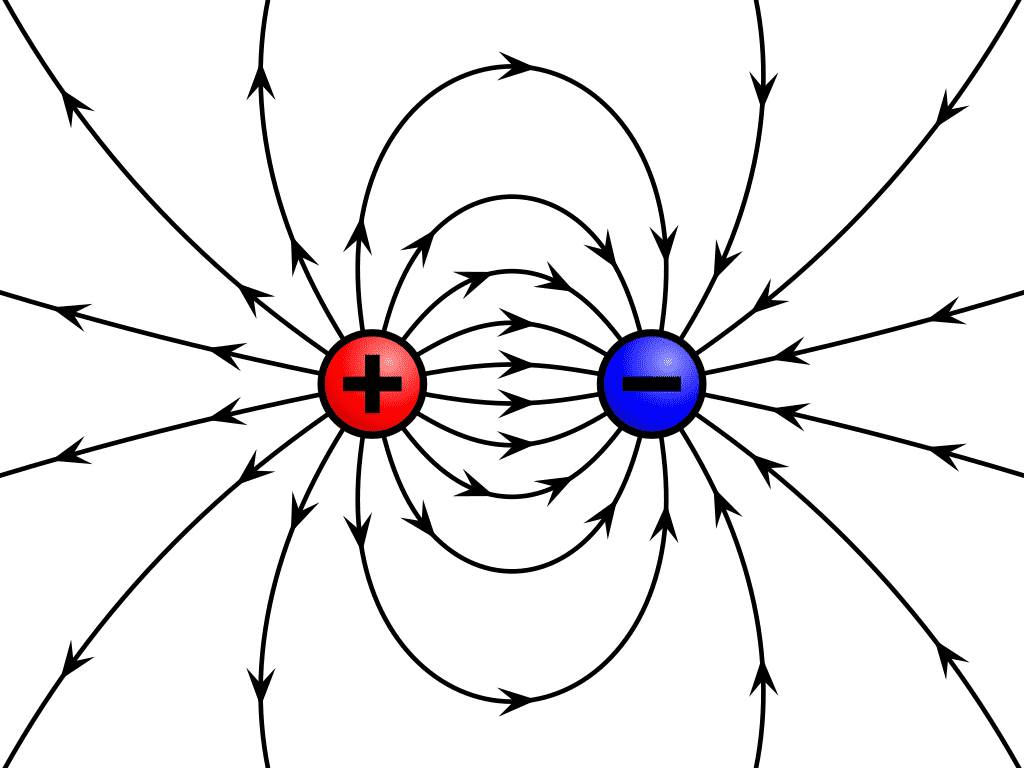
By Geek3 - Own work, CC BY-SA 3.0, Link
If you consider a positive charge and a negative charge which are in motion, the electric field between them (the arrow in the picture) changes in value and direction, as shown below.

Moving electric charges and the electric field
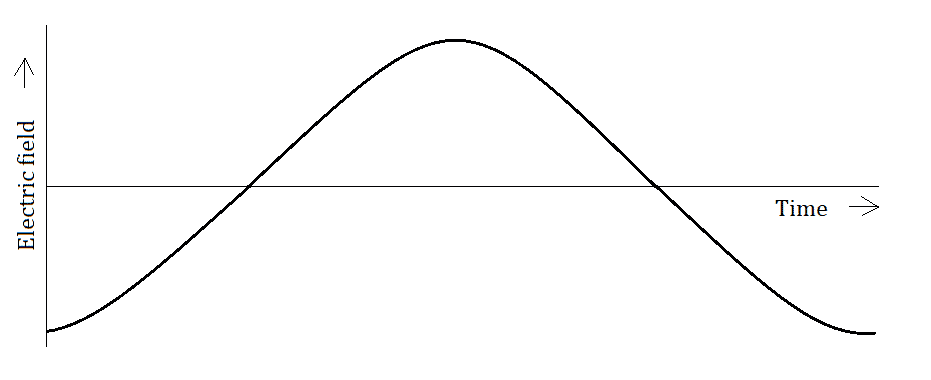
Electric field vs Time
As you can see from the second picture, the change of the electric field, when plotted against time, looks like a sine wave.
Electric field generates a Magnetic field
According to Ampere's Circuital law, a change in the electric field produces a magnetic field. The generated magnetic field is perpendicular to the electric field.
An electromagnetic wave is a combination of oscillating electric and magnetic fields moving through space at the speed of light. Electromagnetic waves can be generated by accelerating a charged particle.
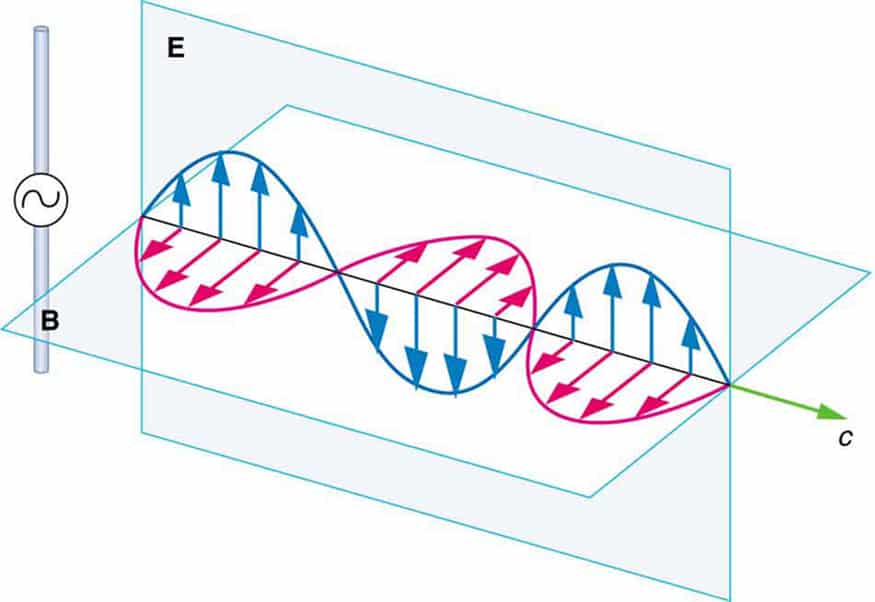
Image credits (E = Electric field, B = Magnetic field, C = direction of movement of the wave with speed of light)
Why is the study of electromagnetic waves important?
Electromagnetic waves are everywhere around us. Therefore, understanding these waves is the key to understanding the functioning of various devices around us. However, in this generation, most of us don't care how these devices work. So, we often end up overlooking their harmful effects.
In the science category, one of our main aims is to help you understand how everything around you work. By reading our blog posts, you can understand the functionality of various devices. Moreover, you will also be able to protect yourself from their harmful effects.
Modes of propagation
Electromagnetic waves can travel in one or more of the following modes. Depending on their wavelengths, they can travel in some modes, but not in others. Each mode has its own advantages.
Line-of-sight
This is the most common mode of propagation of electromagnetic waves. In this mode, the waves travel only in a straight line. They either reach the receiver or are absorbed, reflected, refracted, or diffracted by the particles in the atmosphere. But they cannot travel over obstacles.
As waves travel long distances in a straight line, they tend to move away from the earth. Eventually, at the end of the horizon, they leave the earth, since the earth is spherical. Therefore, repeaters (towers) at regular intervals are indispensable to send these waves over long distances.
Ground waves
If the wavelength of the wave is large enough, obstacles like mountains can diffract these waves towards the surface of the earth once again. Therefore, these waves travel longer along the surface of the earth. These waves are called ground waves.
Skywaves
The waves that leave the earth's horizon are also reflected or refracted back to earth by the charged particles in the ionosphere. These waves are called skywaves.
EM waves vs Atmospheric absorption
There are seven types of EM waves and some of them are hazardous to living beings. But our atmosphere blocks most of these waves that come from outer space. The picture below depicts which wavelengths of EM waves are blocked by the atmosphere and which wavelengths pass through the atmosphere.
7 Types of Electromagnetic waves
Electromagnetic waves are classified based on their frequency. Depending on their frequency, they can have different applications as well as pose different health risks upon over-exposure.
f = c / λ
where f is the frequency of the wave, c is the speed of light and λ is the wavelength of the wave. As you can see, the frequency of the wave increases as its wavelength decreases.
The electromagnetic spectrum consists of electromagnetic waves whose wavelengths vary from several thousand kilometers to a few picometers.
The electromagnetic spectrum is home to 7 types of electromagnetic waves. Each electromagnetic wave has a unique wavelength/frequency range and has distinct characteristics. Arranged in terms of decreasing wavelengths, these 7 types of electromagnetic waves are Radio waves, Microwaves, Infrared light, Visible light, Ultraviolet light, X-rays, and Gamma-rays.
Harmful effects of electromagnetic waves
As the wavelength reduces, the energy of the emitted wave increases. But with the increase in the energy of an electromagnetic wave, the danger it poses to living cells also increases. Hence, radio waves pose the least danger to us since they carry very little energy. On the contrary, at the other end of the spectrum, gamma rays have the most energy and are extremely dangerous.
You can read more about the harmful effects of electromagnetic waves in our blog post here: Dangers of electromagnetic radiation.
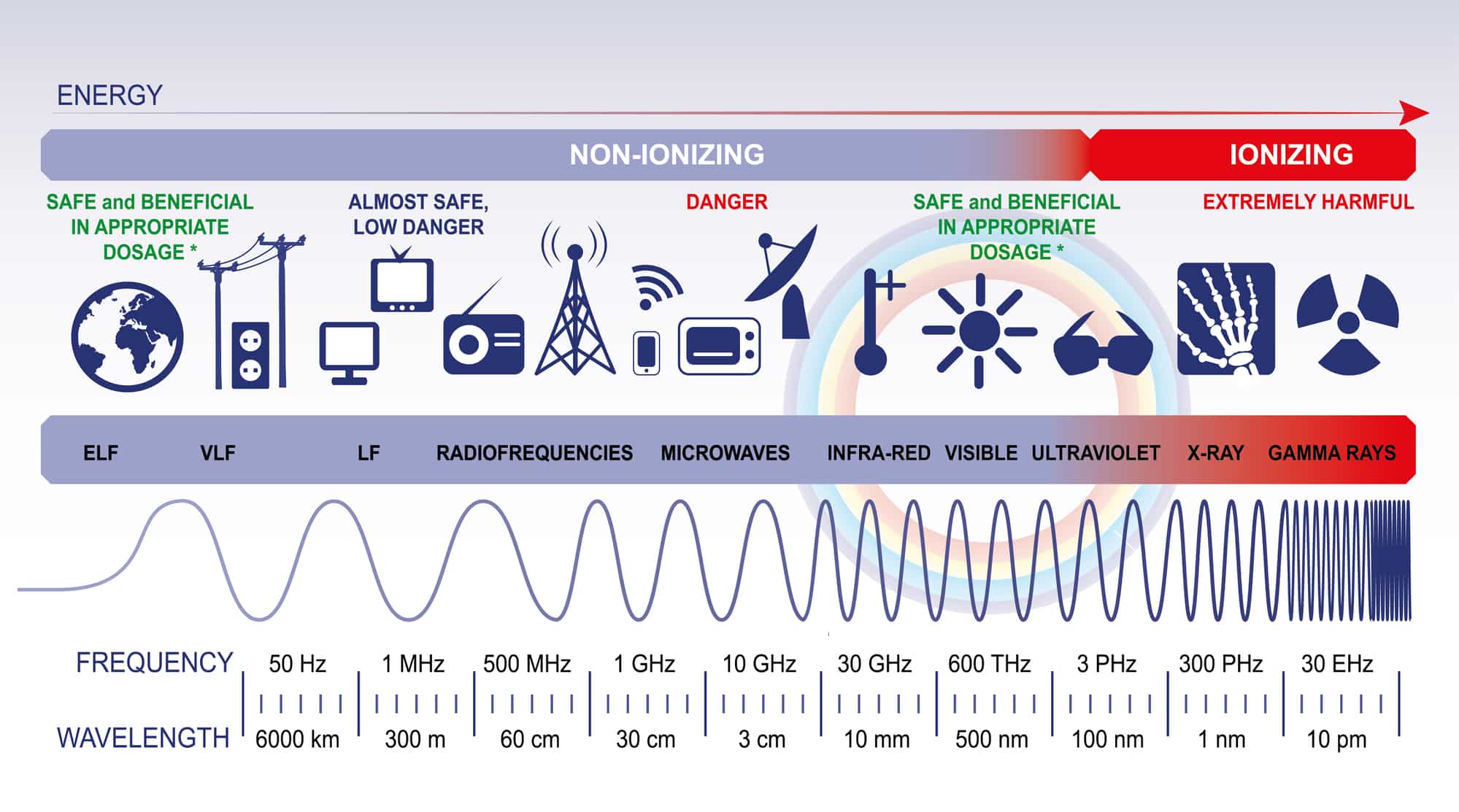
Electromagnetic waves
Food for thought:
Why does the energy increase with an increase in frequency (or a decrease in wavelength)?
I will try to answer it using an analogy.
If you wiggle a rope whose one end is attached to a wall, you will create a wave in the rope. The faster you move your hands, the higher the frequency of the waves generated in the rope, and the more exhausted you will get while doing it.
Similarly, creating a high-frequency wave requires a powerful energy source, and the generated wave carries a huge amount of energy.
1. Radio waves
Radio waves have the longest wavelengths and the least energy of all electromagnetic waves. There are different types of radio waves. Different types of radio waves have different penetrating abilities and have different uses. However, their most common and widespread use is in communication technologies like radio, television, mobile phones, etc.
You can read more about radio waves in our blog post here: Applications of radio waves.
2. Microwaves & Millimeter waves
Today, due to the advancement in technology, generating electromagnetic waves of much shorter wavelengths has become easier. But in the 1920s and 1930s, generating radio waves that have far greater wavelengths (hundreds of meters) was more common. Hence, when physicists discovered microwaves, they noticed that they had relatively smaller wavelengths when compared to radio waves. So they simply named them microwaves because 'micro' meant 'small'.
On the contrary, millimeter waves got their name because their wavelengths lie in the millimeter range (1mm to 1cm).
You can read about microwaves and millimeter waves in our blog post here: Applications of radio waves.
3. Infrared waves
Infrared rays are heat waves given off by most objects. They have wavelengths ranging from 1 mm to 700 nm.
Infrared waves cannot penetrate walls. They travel only through line-of-sight.
Infrared rays are not visible to our naked eyes since we can only see wavelengths between 380 nm and 740 nm. Around 52% of the energy that reaches the earth from the sun is Infrared radiation. But they have very high attenuation. So, we don't use infrared waves for outdoor communication.

Infrared image of a man holding a plastic cover.
Picture credits: NASA/JPL-Caltech/R. Hurt (SSC)
Applications
Nightvision goggles
Most objects emit heat in the form of infrared waves at room temperature. Nightvision goggles use these infrared rays to provide vision at night when the visible light is insufficient.
Remote controls
Remote controls use highly focused and narrow infrared waves generated by infrared LEDs. Since infrared waves cannot penetrate walls, they don't interfere with the functioning of other infrared devices.
Homing of missiles
Missiles are programmed to follow and hit heat sources that emit infrared radiation (the engine of the other aircraft). Thus, infrared waves make the passive homing of missiles possible.
Finding baby stars and planets
Stars emit most of their energy as visible light and less energy as infrared waves.
On the other hand, baby stars and planets emit a lot of infrared radiation because they are colder. Hence, by reading the infrared signatures (instead of visible light) of galaxies and dust clouds, astrophysicists can identify baby stars and planets easily.
Weather forecasting
Along with images in the visible light spectrum, images in the infrared region (from weather satellites) help make weather forecasting possible.
Finding original versions of art pieces
Infrared rays can penetrate the underlying layers in paintings. So, they can reveal if the painting is the original version or a version modified by an artist or someone else.
4. Visible light
Visible light is the range of frequencies that are visible to our naked eyes. You can read more about visible light and its properties in our blog post here: The visible spectrum.
5. Ultraviolet (UV) rays
Ultraviolet rays (in 'Latin' Ultra means 'Beyond') have wavelengths ranging from 400 nm to 10 nm. Some small birds have receptors for UV light. But humans cannot see it.

UV light portrait - wavelengths from 335 to 365 nm.
By Spigget - Own work, CC BY-SA 3.0, Link
UV rays cause suntans and sunburns by making the body release Melanin in response to the damage it does to the skin.
Exposure to UVA rays
UVA rays (not blocked by the ozone layer) have wavelengths ranging from 400 nm to 320 nm. They can create suntans and sunburns that have no health advantages and sometimes cause cancer. Sunscreens provide little protection against suntan caused by UVA rays.
Exposure to UVB rays
However, exposure to UVB rays (320 nm to 280 nm) can create suntans that last for weeks or months and protect the skin from further UV damage with an SPF of 3 (3 times more protection against UV rays than normal skin). Exposure to UVB rays also leads to the creation of Vitamin D in the lower levels of our skin. But the Ozone layer almost completely blocks it. Moreover, sunscreens block most of the UVB rays too.

Sunburn on a woman's back.
By FAL101 at English Wikipedia - Own work by the original uploader, CC0, Link
Food for thought:
Can you protect yourself from UV rays by sitting in the shade?
No.
Even if you are in the shade, UV rays can still reach your skin and eyes indirectly and damage them. That's why proper clothing, hats, sunscreen, and sunglasses are required to protect yourself from UV radiation, even if you are sitting in the shade.
Are people with fair skin more susceptible to sunburns than darker people?
Yes. The natural pigment melanin, besides being responsible for our skin-, hair- and eye-colors, also protects our skin from getting burned. Darker people, who have a higher concentration of melanin, are more immune to UV radiation than people with fair skin. Therefore, they can stay longer in the sunlight without getting tanned or getting burned.
Applications
Some materials can glow and fluoresce when exposed to UV light. Fluorescence is the phenomenon in which some materials absorb light of lower wavelengths (For example, UV light) and emit radiation of higher wavelengths (For example, visible light).
This fluorescence-property of UV light has many applications:
1. Crime-scene inspection (Bodily fluids like saliva, semen, and urine fluoresce when exposed to UV light)
2. Identifying counterfeit currency notes
3. Detecting the presence of pests in agriculture (Urine of rodents fluoresce when exposed to UV light), and
4. Verifying the originality of art and collectibles, etc.
6. X-rays
X-rays are electromagnetic waves with wavelengths ranging from 3 nm to 0.03 nm.
How are X-rays produced?
When accelerated electrons hit atoms of metals (Copper, Galium, etc.), they make the electrons in inner orbits leave their orbits. As a result, the atoms of these metals become unstable. So, electrons from the outer orbit move to the inner orbit to stabilize the atom, thereby releasing an X-ray in the process.
How did X-rays get their name?
The German physics professor Wilhelm Röntgen, who discovered the X-rays on November 8th, 1895, didn't know what type of radiation it was. So, he referred to the radiation as 'X.' This gave X-rays their name.

X-ray of chest.
Picture credits & License
Applications
Scans
The most common application of X-rays is in creating scans.
An X-ray scan uses X-rays to create medical imagery of an interior body part. X-rays are attenuated slightly by soft tissues and organs but are attenuated heavily by the Calcium in the bones. Therefore, on the Radiograph (image produced by X-rays or Gamma rays for medical purposes), the bones appear as white.
A CT (Computed Tomography) scan combines several X-rays (taken at different angles) to obtain a 3D-image of the body part.
Airport security systems use X-rays to scan your luggage.
Fighting cancer
X-rays are ionizing. Therefore, radiotherapy uses X-rays to kill cancerous cells in the body. Thus, X-rays play a major role in fighting cancer.
Astronomical observations
Several celestial bodies, like Black holes and neutron stars, emit X-rays. So, studying these X-rays help understand these bodies better. But our atmosphere almost completely blocks X-rays from outer space. So, astrophysicists install X-ray telescopes at very high altitudes or in an artificial satellite.
7. Gamma-rays
Gamma-rays are very similar to X-rays. However, their major difference is in the way they are produced. While X-rays are produced by electrons, Gamma-rays are produced by nuclei.
How are Gamma rays produced?
After a radioactive material decays, the resulting daughter nucleus that is in an excited state releases a Gamma-ray to reach a stable, low-energy state. Hence, both nuclear fission and nuclear fusion can produce Gamma-rays.
Applications
Fight cancer
Similar to X-rays, the ionizing property of Gamma-rays is useful in the medical field for killing cancer and tumor cells. A Gamma knife surgery focuses multiple concentrated Gamma rays on a cancerous growth from different angles. Thus, it minimizes damage to healthy tissues while destroying the cancerous growth.
Astronomical observations
Massive stars release a huge amount of energy and a large amount of Gamma-rays when they collapse. However, this phenomenon, called a Gamma-ray burst, is very rare because it lasts only for a very short time. For example, a Gamma-ray burst can release more energy in 10 seconds than the sun can emit in 10 billion years. Therefore, by analyzing Gamma-rays, such phenomena can be studied. But just like X-rays, our atmosphere almost completely blocks Gamma-rays too. So, astrophysicists install Gamma-ray telescopes at very high altitudes or in an artificial satellite to study Gamma-rays from outer space.
For example, the image below was recorded by NASA's Swift satellite. It depicts a gamma-ray blast caused by the birth of a black hole 12.8 billion light years away (below). This object is among the most distant objects ever detected.
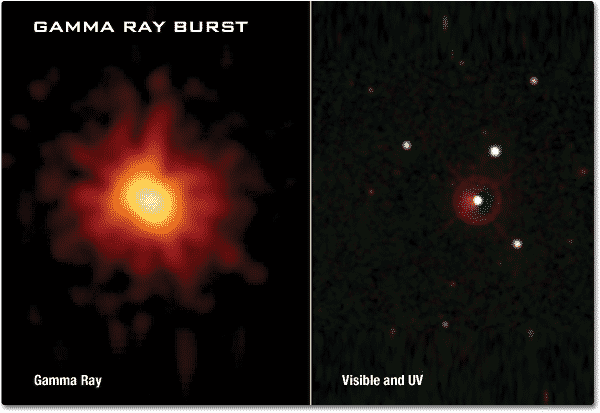
Picture credits: NASA/Swift/Stefan Immler, et al.
Gamma-rays also help determine the elements on other planets.
Sterilization
Gamma rays can kill microorganisms like fungi, bacteria, and viruses. Therefore, they are used for sterilization in various fields:
1. Medical fields - to sterilize surgical tools and disposable syringes before use.
2. Hygiene - to sterilize food items (like frog legs) to improve hygiene.
3. Art - to sterilize pieces of art, thereby killing the microorganisms on these art pieces and protecting them against degradation.
We hope that this blog post helped you understand what the 7 types of electromagnetic waves are, how they are produced and what their uses are. If you liked this blog post, please share it with your friends.
